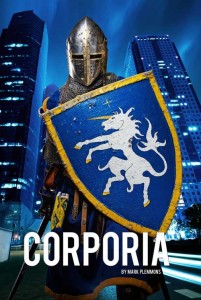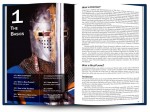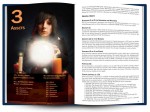Corporia
Corporia is a complete RPG being funded via Kickstarter.
By Mark Plemmons.

Learn more about Corporia here.
Back the Kickstarter here.
Welcome to the latest Designer’s Diary, a column where designers are given the opportunity to take readers on an in-depth ride through the design and development process of their system, setting, or product. If you’d like to share your product in the Designer’s Diary column, send a message to aaron@roleplayerschronicle.com.
Designer’s Description
Corporia is a tabletop role-playing game that mixes multiple concepts to create a unique urban fantasy setting. In the near future, mega-corporations rule clean, shining metropolises where the wage-enslaved citizenry are kept mostly docile by cheap fast food and mood tranquilizers, free but restricted internet access, and the promise of a job. In this time of mankind’s oppression, Lancelot and other reincarnated figures from the Arthurian legends are awoken to fight the corporate Order and restore justice and freedoms to the land.However, the return of the knights also breached the fabric of dimensional reality, allowing entry into our world for the forces of Chaos. Reports of magics, monsters, and mutated humans are growing more common, causing Lancelot to gather allies and form the Knightwatch – a strike force of supernaturally-powered characters and reborn knights who will hold the line between the forces of Chaos and Order rather than seek to control each other and achieve ultimate domination over the human race.
Players take on the roles of members of the Knightwatch, a small team of individuals with supernatural abilities who make up the elite special operations unit of the Watchman private security company, under the auspices of its mega-corporate entity Valyant and Chief Executive Officer Lance Martin – the reincarnated Sir Lancelot du Lac. The Knightwatch resolve extreme incidents involving manifestations of Chaos magic (aka the Flux) that regular officers are unable to handle, including mutated humans, monsters from other dimensions, and corporate Flux experiments gone wrong.
Purpose
I’ve always loved genre-blending fiction, and Arthurian legends and cyberpunk have always been two genres I’ve really enjoyed. When I decided that I wanted to create a role-playing game of my own, it just seemed like the perfect blend.
 Influences
Influences
The original Deadlands setting, because of its simple Target Number resolution system and the fact that the players are working to keep the truth of magic and monsters a secret, particularly influenced me. Another inspiration was C.J. Carella’s Witchcraft, because of the way that points are allocated in character creation to allow focus on physical and mental abilities, or supernatural abilities, or a mix of the two. Cyberpunk 2020 was also a particular influence because I liked its mix of character classes. Of other note were the World of Darkness and Everlasting games.
There were plenty of media inspirations, but the strongest was probably the old DC Comics series Camelot 3000. Others included the TV shows Angel, Torchwood, and even the old “Outlaws” western from 1986, which featured cowboys from the past coming to the future. Max Barry’s Jennifer Government novel was also inspiring. I also think that the movie Sucker Punch is a good example of what Hacker characters can do, diving into an infinite array of virtual worlds and bringing the other players along with them.
 Research
Research
I already had several books on Arthurian legend, so that was easy. Most of my other research involved reading scientific and technological speculations of what might come to pass in the next few decades. On the design side, I did lots of research into page design and typography to determine what sort of look and feel I wanted Corporia to have.
 Art Direction
Art Direction
Lots of role-playing books still use the original D&D books for their graphic design and page layout templates, even those that aren’t intentionally imitating that old-school feel. I wanted Corporia to be visually striking in a different way, so the page design is very much based on modern magazines and graphic design – particularly those sections of the book that are written in the style of a magazine, corporate report, or similar document taken from the future world of the setting.
To further differentiate Corporia’s look and feel, I primarily went with photographs rather than illustrations. These are professionally shot images that feature business executives wielding medieval weapons, costumed humans as monsters or mutated people, and a variety of digitally manipulated images to show electronic life forms, humans wielding magic, and bizarre mutations that can’t be done even with the best costuming. The final result is something that I’m really proud of!
Gaming Experience
Corporia is designed to allow players to focus on multiple genres, as they desire. The easiest way to play Corporia is what I call “freak of the week”, where the characters can fight a different villain every week, like you might see on X-Files, Supernatural, Buffy, or any other periodically-produced media. However, it also allows for corporate espionage and other types of intrigue as well. There are also options for lots of moral dilemmas that the characters will have to resolve: Will you ally with rival corporate security forces to face off against magical threats – or is getting in bed with the enemy too far down the path of corruption? Can you risk allowing a monster to live – even if an innocent human may lie beneath its horrific shape? Can you trust that your allies are not fallen knights, corrupted to throw in with the corporations or forces of chaos? Can you fully support Lancelot in his role of a corporate CEO and assist him in taking morally ambiguous actions to maintain his power base – or will you take a stand and weaken him in the eyes of the other ruling corporations?
 Comparison
Comparison
Corporia gives a unique blend of themes that you won’t find in any other role-playing games that I’m aware of. The rules are simple (roughly 8 pages for ability use and combat) without being restrictive. For instance, in Corporia, the Hacker isn’t off on his or her own mission while the other players are relegated to sitting around and waiting. Spellcasters can easily modify their spells and create new ones, rather than being restricted to only what’s provided in the book. Wounded characters are still able to prevail in their fights, and don’t fall into a ‘death spiral’ where it becomes exponentially harder to succeed. The rules focus on the positives, making characters unique and interesting through a series of traits and assets, not saddling them with penalties and hindrances that can just be exploited or ignored.
Development Process
Corporia started a series of rough scrawlings in a notebook, and then got further fleshed out as I sat in front of my keyboard for hours on end. However, a significant portion of the writing and editing was actually done in tandem with the page design and layout process.
Most writers tend to create the entire text first and then hand it off to someone else to drop into a page layout, which is usually the best procedure. However, in my decade-plus of game writing and page design, I’ve found that the challenge of writing to fit a particular space or word count makes me more creative. Also, a lot of the ‘feel’ of Corporia comes from the book design and art, and I wanted these to really sync up into a cohesive whole. Even though I’ve already worked on hundreds of comic and role-playing game products, it was still a challenge, but a good one! I’m very pleased with the final result, and I think everyone will agree that whether it’s their type of game or not, Corporia is a striking work and a game that really stands out on its own.

